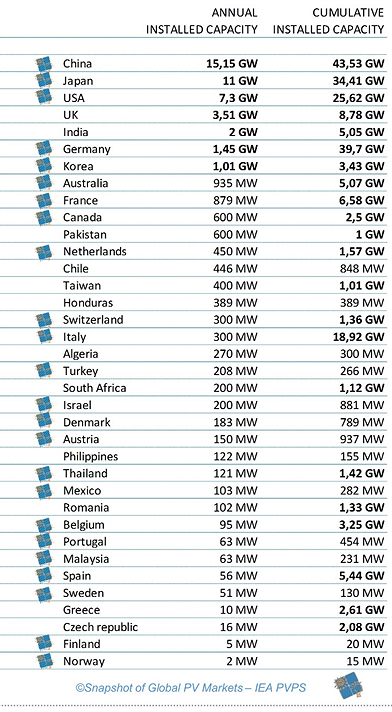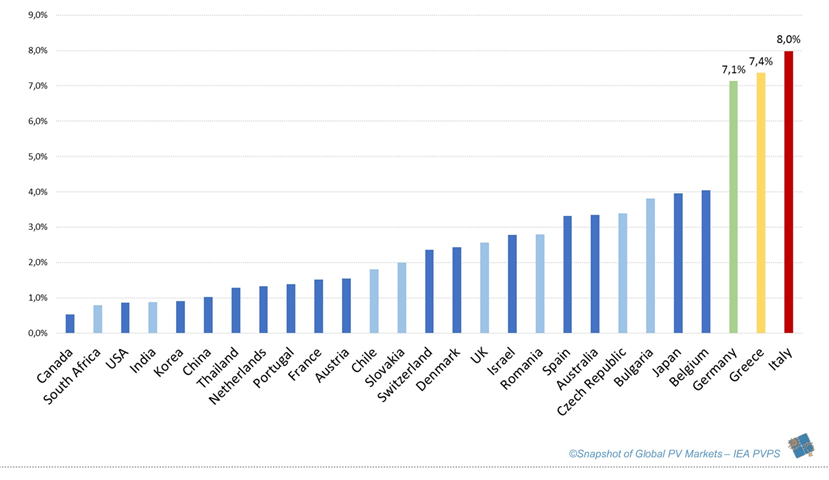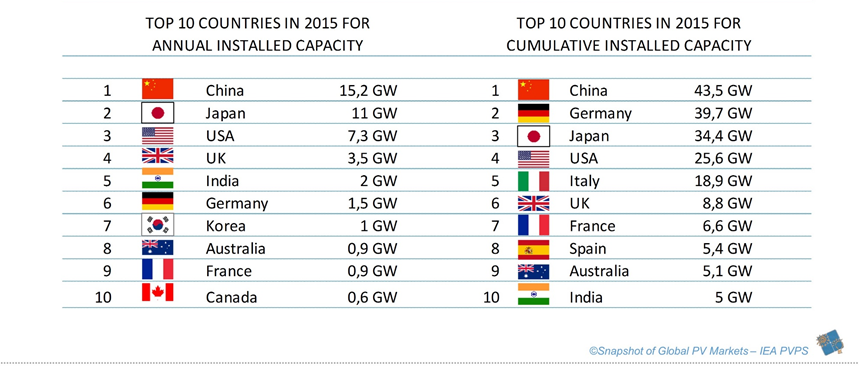The Power of Sun: A Snapshot of Global Photovoltaic Markets
Our society greatly relies on energy use. Energy resources, such as oil and gas, are limited and their availability is strongly connected – although not limited – to both the relations with producer-countries and their political stability. In order to clear the threats to energy security, especially in a climate of political tensions (Heshmati & Abolhosseini, 2016), and to reduce the greenhouse emissions (Creutzig et al., 2014) related to the employ of fossil fuels, we are experiencing an energy transition towards the deployment of renewable energy.
In the last decades the spread of renewable sources of energy has been variously supported – also financially – by local governments that determined the success of one or the other energy source.
Recently, the International Energy Agency (IEA) released the data related to the global photovoltaic deployment aiming at providing information concerning the development of the PV market in the last years.
At the end of 2015 the globally installed capacity was at least 227.1 GW, 10 times higher than in 2009. 30 GW are supposed to have been installed in countries that do not participate in the Photovoltaic Power System (PVPS) programme, but the remaining 197 GW of cumulative PV installations have been deployed in 24 IEA PVPS countries. The snapshot shows that after a limited growth of the photovoltaic market in 2014, 2015 has been the year of records with an expansion of 25% – corresponding to a global installed capacity of 50 GW – compared to the 40 GW of the 2014. Nowadays, PV provides about 1.3% of the global energy demand. China, Germany, Japan, the USA and Italy are the leading countries with respectively 43.5 GW, 39.7 GW, 34.4 GW, 26.5 GW and 18.9 GW of cumulative installed PV capacity (Table 1). All the other countries have installed less than 10 GW each.

Table 1 Annual and cumulative installed PV power 2015. Source of the caption and table: (International Energy Agency, 2016)
In 2015, China broke the record of the highest annual installed capacity in a single country with 15.2 GW and 43.5 GW of cumulative installed capacity at the end of the same year. Impressing is the growth also in developing countries and in new markets such as India with more than 2 GW installed and Pakistan that appears to be promising with its several hundreds of MW together with Turkey that installed for the first time 208 MW. In Africa, South Africa was a leading country in 2014 with 2 GW installed, but it has experienced a decline in 2015 with a subsequent restart. Besides, in 2015, in the USA, the PV market of North America reached 7.5 GW.
In 2015, Europe experienced a decline since in various countries was phased-out the feed-in-tariff and, in others, such as Germany, the supporting scheme was modified. In Europe, the installed PV represents at least 3.5% of its electricity demand and approximately 7% of the peak electricity demand. In 2015 the increase in the British PV market was dominant in Europe for the second year in a row with 3.5 GW. Nevertheless, in Europe, Germany is still the leading country with 39.7 GW of cumulative installed capacity in 2015. Particularly important are the data about the ratio between the PV installed capacity and the energy demand of a country since it is referred to its energy security. The PV installed capacity in Italy, Greece and Germany covers respectively 8%, 7% and 7.1% of their electricity demand (Figure 1).

Figure 1 National PV penetration in % of the electricity demand based on 2015 capacities. Source of the caption and figure: (International Energy Agency, 2016)
In the last years Europe contributed mostly to the global PV installation, although since 2012 the PV capacity installed in Asia is rapidly growing. Nowadays, both Europe and Asia represent approximately 42% of the total installed capacity, the USA supplies the 13% and the Middle East and Africa together contribute to the remaining 3% (Table 2).

Table 2 Top 10 countries for installations and total installed capacity in 2015. Source of the caption and table: (International Energy Agency, 2016)
At the end of 2016 it is foreseen that the PV installed until January 2016 will provide around 275 billion kWh that represents approximately 1.3% of the global electricity demand.
References:
Creutzig, F., Goldschmidt, J. C., Lehmann, P., Schmid, E., Blücher, F., von Beyer, C., … Wiegand, K. (2014). Catching two European birds with one renewable stone: Mitigating climate change and Eurozone crisis by an energy transition. Retrieved from http://www.sciencedirect.com/science/article/pii/S1364032114004808
Heshmati, A., & Abolhosseini, S. (2016). European energy security. Challenges and green opportunities. Retrieved from https://www.wider.unu.edu/sites/default/files/wp2016-21.pdf
International Energy Agency. (2016). 2015 A Snapshot of Global Photovoltaic Markets. Retrieved from http://www.iea-pvps.org/fileadmin/dam/public/report/PICS/IEA-PVPS_-__A_Snapshot_of_Global_PV_-_1992-2015_-_Final_2_02.pdf
When you subscribe to the blog, we will send you an e-mail when there are new updates on the site so you wouldn't miss them.


Comments 3
That's all nice and good, but looking only at percentages of growth is deceiving:
1- The proportion of PV electricity generation is still abysmally small compared to what is needed (1.3%);
2- Is this growth actually replacing fossil fuels, or is it addtionnal? (see Richard York's paper on the topic: http://dx.doi.org/10.1038/nclimate1451)
I wouldn't say that "we are experiencing an energy transition towards the deployment of renewable energy" quite yet...
Thanks for the comment, Jps, particularly the link to York's article. I am not an expert on the field, but i do agree that without a real sea-change (of economic systems and relations of productions) it is very inlikely that the technological development will be enough to halt environmental devastation and climate change. And that is a proof: if you leave the play to the market, there will not be replacement, but exploitation of all possible sources of revenue, fossul fuel and other sources.
This is, in my opinion, the reason why COP21 was a total failure...
Dear jps and dear Simone, thanks for the comments. Unfortunately, I had not the chance to read Richard York´s article. Anyway, what data say is that the share of PV electricity is still small - as you, jps, correctly say - but increasing: "At the end of 2015 the globally installed capacity was at least 227.1 GW, 10 times higher than in 2009." This phenomenon hopefully defines a direction that is, for sure, positive. Maybe the expression "we are experiencing an energy transition toward the deployment of renewable energy" might sound naive, but actually I would prefer to define it optimistic. I think that an "optimistic view" is necessary when we talk about climate change mitigation measures. If we rather assume a catastrophic approach, any effort can be considered vain. On the other hand, as correctly says Simone, we have to realize that the efforts are still not enough. Well, more can be done, this is not enough! I agree with you Simone, but still we can take credit for having taken a small step...